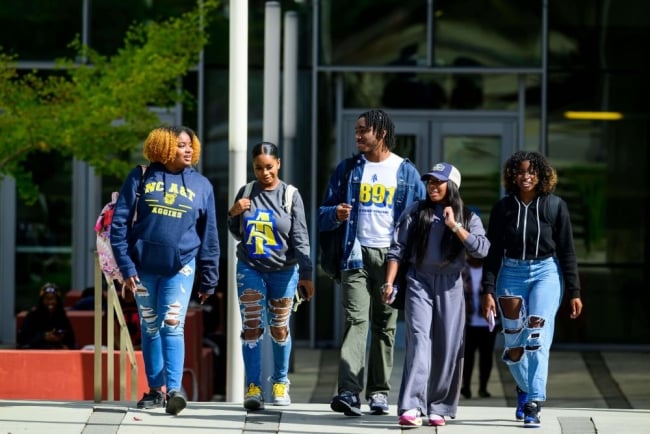You have /5 articles left.
Sign up for a free account or log in.

North Carolina A&T State University has reached the highest endowment of any public HBCU.
North Carolina A&T State University
North Carolina A&T State University’s endowment hit $202 million this summer, the highest of any public historically Black college or university (HBCU) in the country. That sum is about 10 times larger than it was 15 years ago, when the endowment stood at a more modest $20 million.
University leaders are celebrating the news.
“As our endowment grows, it provides significant income to fund programs and enhance operations at North Carolina A&T,” outgoing Chancellor Harold L. Martin said in an announcement. “It also increases our funding flexibility, allows us to plan more effectively for future initiatives and lends strength to our bond ratings—all important in a highly competitive higher education marketplace.”
It took hard work and planning to get the university to its current endowment level, but it needed to be done, Kenneth Sigmon, vice chancellor for university advancement at North Carolina A&T, said in an interview.
“In today’s world, we have to compete worldwide, not just with other HBCUs … for researchers, for students, for programs, for all of those kind of things,” he said. “When you look at the common denominator among all of the household name institutions, and the ones that lead the pack, so to speak, they all have significant funding. It was one of the things that we obviously knew we were missing.”
In the past, the university wasn’t quite “investment ready,” Sigmon said. It didn’t have the staff or infrastructure to manage large gifts. So the university hired an advancement team and launched a fundraising campaign with a goal of raising $85 million. That campaign ended in 2020 and yielded a whopping $181.4 million, including about 40 gifts of at least $1 million from individual donors, corporations and foundations.
The university received a $45 million gift from philanthropist MacKenzie Scott in 2020. This year, it received a $20 million gift from an anonymous donor. In all, the university has raised about $300 million over the last decade.
Some of that has gone to immediate needs, Sigmon noted, but wise investments paid off.
“I hate to say it’s not rocket science,” he added, “but it’s really just putting the best practices in place, making the case for support—why it’s necessary, how it’s going to impact the university, and then showing that it can be done.”
Overcoming Decades-Old Disparities
The $202 million sum is no small feat among public HBCUs, whose endowments tend to lag behind their private university counterparts. HBCUs, on average, also have significantly lower endowments than predominantly white institutions.
Endowments per full-time equivalent student at public non-HBCUs are three times higher than those at public HBCUs, on average, according to recent research from the Century Foundation, a progressive think tank focused on equity in education, healthcare and the workforce. Private non-HBCUs have endowments per student that are four times as high as private HBCUs, on average.
The endowment gap is especially wide for historically Black land-grant universities, such as North Carolina A&T. The country’s non-HBCU land-grant universities collectively hold $45 billion in endowment assets, compared to land-grant HBCUs, which together hold about $1 billion.
Denise A. Smith, deputy director of higher education policy at the Century Foundation, has called on the federal government to invest $40 billion in HBCU endowments over the next ten years.
She believes HBCU endowments badly need the boost, especially after the U.S. Supreme Court struck down race-conscious admissions last summer and as state bills against diversity, equity and inclusion efforts proliferate. She expects more Black students are likely to turn to HBCUs as it becomes harder to access targeted supports at other colleges and universities.
“It’s critical that we really think about, ‘How do we fortify these institutions?’” she said in an interview.
Harry Williams, president and CEO of the Thurgood Marshall College Fund, which represents public HBCUs, said part of the problem is that states have chronically underfunded historically Black land-grant institutions for decades, relative to their predominantly white counterparts.
North Carolina A&T’s achievement is a “big deal,” he said, but at the same time, its neighbor, the University of North Carolina at Chapel Hill has an endowment exceeding $5 billion. In another example, North Carolina State University’s endowment is at least $2 billion.
What North Carolina A&T accomplished “is great, don't get me wrong,” Williams said, “but the reality is A&T has been here for over 100-some-odd years, and if they were funded where they were supposed to be, their endowment would probably be in the billions.”
Meanwhile, HBCUs face extra challenges accessing and growing some of the funds they do have, according a survey of endowment professionals at private HBCUs conducted by the United Negro College Fund (UNCF), which represents private HBCUs, and by PGIM, a global asset management company.
The survey of 22 HBCU endowment professionals found that 86 percent of the institutions represented were restricted to using endowment funds for scholarships, while most non-HBCUs could spend endowment money on research, campus infrastructure, academic programs and other needs. Private HBCUs also generally had only one internal professional focused on investment management, while non-HBCUs had six internal investment staff members, on average—plus support from external asset managers.
There’s been some work done to rectify endowment disparities in recent years. The UNCF received $100 million earlier this year to create an endowment pool for 37 HBCUs from the Lilly Endowment Inc., a foundation focused on religion, education and community development. The organization set a goal to raise $370 million in total for the pool, though the Lilly gift alone would lift each institution’s endowment by $2.7 million and double the endowments of several institutions.
“We believe this is the most prudent way to use Lilly Endowment’s transformational support,” Michael L. Lomax, president and CEO of UNCF, said at the time.
Balancing Immediate Needs with Long-Term Investment
In addition to years of underresourcing, HBCUs often have too many immediate needs to sock away money for the future, said Walter Kimbrough, interim president of Talladega College and former president of Dillard University and Philander Smith University.
Building up an endowment is a luxury “when you really don’t have enough to support the students that you have and the programs that you have,” he said, adding that HBCUs enroll high percentages of low-income students who often need extra financial support to cover the costs of college.
He compared the dynamic to American families who want to save up but have to pay their bills instead.
At Philander Smith, Kimbrough said he felt like he had “little to no opportunity” for endowment-building, though the endowment did grow some. In the 1980s, the institution received a Title III Endowment Challenge Grant, part of a U.S. Department of Education program designed to help institutions grow their wealth.
Smith has explored this program in her research, finding that while it’s helpful, it can also present challenges. It requires recipients to match the grant amount, limits grants to less than $1 million and doesn’t allow the funds to be expended during the grant period, among other restrictions. She’s also found, based on federal data, that only about a third of HBCUs used the program between 2017 and 2022.
Kimbrough then saw Dillard University’s endowment double during his decade there, from about $50 million to about $100 million. This was helped by a $25 million grant from the National Institutes of Health in 2011, just before he arrived. But when Dillard got donations, he couldn’t save all of those dollars because he often had more pressing issues at hand. Much of the money raised during that period, at least $5 million, went directly to address students’ financial needs.
At Talladega College, endowment growing is the least of Kimbrough’s concerns. He said he’d love to put part of a large donation into the endowment if one came through, but “it’s just not a priority right now,” he said. “We’re dealing with the here and now.”
But he emphasized that endowment-growing efforts should be a long-term, strategic goal for the college and HBCUs writ large: “Endowment building leads to permanence of an institution.”
At North Carolina A&T, Sigmon said the growing endowment has already opened up new opportunities.
Since the university’s initial fundraising campaign, he estimates the number of endowed scholarships available to students tripled, while the number of endowed chairs and professorships doubled. He believes having those positions is good news for the present and for the future—North Carolina A&T is among those HBCUs vying for R-1 status, the coveted Carnegie Foundation classification reserved for doctoral universities with a certain level of research prowess. He hopes these kinds of roles attract the “best and brightest” researchers to make the R-1 goal a reality.
Sigmon sees preeminent research institutions—HBCUs and non-HBCUs alike—as his university’s competition, and now he feels more equipped to take them on.
“We announced $200 million, and my trustees look at me and go, ‘OK, $250 now,’” Sigmon said. “And that’s the truth. We’re just going to keep on moving and keep on leapfrogging many of those institutions because [North Carolina A&T] is a worthy investment.”





